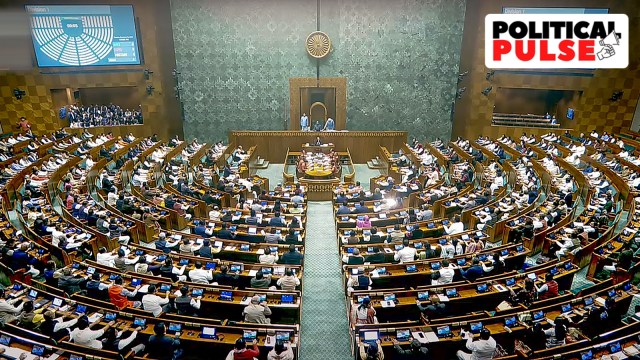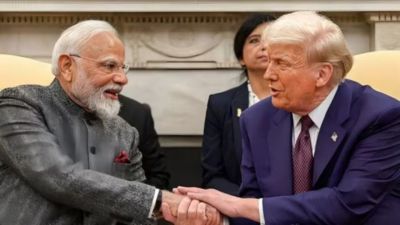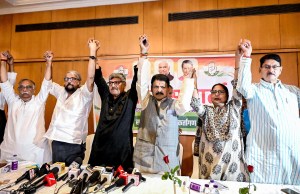Did Opposition score a ‘win’ as government introduced ‘One Nation, One Election’ Bills? What the rules say
Opposition MPs say the government failed to secure a two-thirds majority. However, experts say a special majority is not required to introduce Constitution Amendment Bills.
 Members in the Lok Sabha during the Winter session of Parliament, in New Delhi, Tuesday, Dec. 17, 2024. (PTI Photo)
Members in the Lok Sabha during the Winter session of Parliament, in New Delhi, Tuesday, Dec. 17, 2024. (PTI Photo) Amid strong objections from Opposition INDIA bloc members, the controversial Bills on implementing “One Nation, One Election” were introduced in the Lok Sabha on Tuesday after a division, in other words voting, which saw 269 members favouring their introduction and 198 opposing.
Union Home Minister Amit Shah and Parliamentary Affairs Minister Arjun Ram Meghwal told the House that the government was ready to refer the two Bills to a joint committee of Parliament for detailed consideration.
Several Opposition MPs had given notices opposing the introduction of the Bills. Clauses 72(1) and 72(2) of the Rules of Procedure and Conduct of Business in the Lok Sabha allow any member to give prior notices opposing the introduction of a Bill.
Congress MP Shashi Tharoor hit out at the government, saying voting at the introduction stage of two Bills showed the BJP did not have the two-thirds majority required to pass the Constitutional amendment.
“We (the Congress) are not the only ones that have opposed this Bill. The vast majority of the Opposition parties have opposed this Bill and the grounds are very many, it is a violation of the federal structure of the Constitution. Why should a state government fall if the Central government falls?” he told reporters on Parliament premises.
“My view is that this entire thing is a folly. In any case, the votes today have demonstrated that the BJP does not have the two-third majority required to pass a constitutional amendment,” he said.
Though Opposition MPs claimed victory saying that the government could not secure a two-thirds majority for introducing the Bills, former Lok Sabha secretary general P D T Achary told The Indian Express that a special majority, which means a majority of more than 50% of the total membership of the House and a majority of two-thirds of the members of the House present and voting, was not required for the introduction of a Constitution Amendment Bill. A reading of parliamentary rules shows that a Bill, even if it is a Constitution Amendment Bill, does not require a special majority at the stage of introduction or while being referred to a Select or Joint Committee. A special majority is required only in the subsequent stages.
Article 368 on Parliament’s power to amend the Constitution says, “An amendment of this Constitution may be initiated only by the introduction of a Bill for the purpose in either House of Parliament, and when the Bill is passed in each House by a majority of the total membership of that House and by a majority of not less than two-thirds of the members of that House present and voting, it shall be presented to the President who shall give his assent to the Bill and thereupon the Constitution shall stand amended in accordance with the terms of the Bill.”
M N Kaul and S L Shakdher’s Practice and Procedure of Parliament also says “taking a strict interpretation of the constitutional provision, the special majority prescribed therein may be required only for voting at the third reading stage, but by way of caution the requirement for special majority has been provided for in the rules in respect of all the effective stages of the Bill, e.g., motion that the Bill be taken into consideration; motion that the Bill as reported by the Select or Joint Committee be taken into consideration; for passing of clauses and schedules to the Bill; and the motion that the Bill be passed. Thus, motions that the Bill be circulated for eliciting public opinion thereon or that the Bill be referred to a Select or Joint Committee are passed by simple majority only.”
What do the rules say?
Rule 157 of the Rules of Procedure and Conduct of Business in Lok Sabha, in the chapter Bills seeking to amend the Constitution, clearly lays down the process. “If the motion in respect of such Bill is that: (i) the Bill be taken into consideration; or (ii) the Bill as reported by the Select Committee of the House or the Joint Committee of the Houses, as the case may be, be taken into consideration; or (iii) the Bill, or the Bill as amended, as the case may be, be passed; then the motion shall be deemed to have been carried if it is passed by a majority of the total membership of the House and by a majority of not less than two-thirds of the members present and voting,” it says.
As for voting by division, Rule 158 says, “Voting shall be by division whenever a motion has to be carried by a majority of the total membership of the House and by a majority of not less than two-thirds of the members present and voting.”
And “if the result of the voting shows that the majority of the total membership of the House and the majority of not less than two-thirds of the members present and voting are in favour of the motion, the Speaker shall, while announcing the result, say that the motion is carried by a majority of the total membership of the House and by a majority of not less than two-thirds of the members present and voting”.





- 01
- 02
- 03
- 04
- 05


























